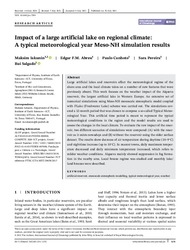Impact of a large artificial lake on regional climate: A typical meteorological year Meso‐NH simulation results
DOI: https://doi.org/10.1002/joc.7299
Persistent URL: http://resolver.sub.uni-goettingen.de/purl?gldocs-11858/9849
Persistent URL: http://resolver.sub.uni-goettingen.de/purl?gldocs-11858/9849
Supplement: http://mesonh.aero.obs-mip.fr/mesonh54/Download
Iakunin, Maksim; Abreu, Edgar F.M.; Canhoto, Paulo; Pereira, Sara; Salgado, Rui, 2021: Impact of a large artificial lake on regional climate: A typical meteorological year Meso‐NH simulation results. In: International Journal of Climatology, Band 42, 2: 1231 - 1252, DOI: 10.1002/joc.7299.
 |
Dokument öffnen: |
Large artificial lakes and reservoirs affect the meteorological regime of the shore area and the local climate takes on a number of new features that were previously absent. This work focuses on the weather impact of the Alqueva reservoir, the largest artificial lake in Western Europe. An extensive set of numerical simulations using Meso‐NH mesoscale atmospheric model coupled with FLake (Freshwater Lake) scheme was carried out. The simulations covered a 12‐month period that was chosen to compose a so‐called Typical Meteorological Year. This artificial time period is meant to represent the typical meteorological conditions in the region and the model results are used to assess the changes in the local climate. To evaluate the raw impact of the reservoir, two different scenarios of simulations were compared: (A) with the reservoir as it exists nowadays and (B) without the reservoir using the older surface dataset. The results show decrease of air temperature during daytime (10–9°C) and nighttime increase (up to 10°C). In nearest towns, daily maximum temperature decreased and daily minimum temperature increased, which refers to milder weather conditions. Alqueva mainly showed suppression in fog formation in the nearby area. Local breeze regime was studied and monthly lake/land breezes were described. Large lakes and artificial reservoirs can affect the meteorological regime of their coastal areas and impact the local climate. This work focuses on the weather impact of the Alqueva reservoir, the largest artificial lake in Western Europe, studied on the basis of mesoscale atmospheric modelling data over the 12‐month period composed in a typical meteorological year for the region of interest.
Statistik:
ZugriffsstatistikSammlung:
Schlagworte:
artificial reservoirmesoscale atmospheric modelling
typical meteorological year
weather
This is an open access article under the terms of the Creative Commons Attribution‐NonCommercial License, which permits use, distribution and reproduction in any medium, provided the original work is properly cited and is not used for commercial purposes.

